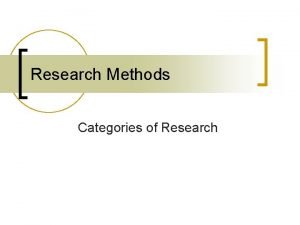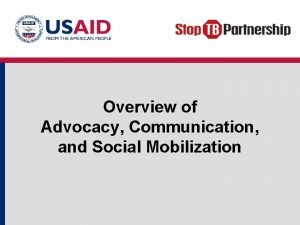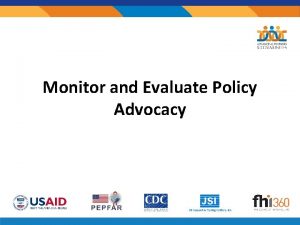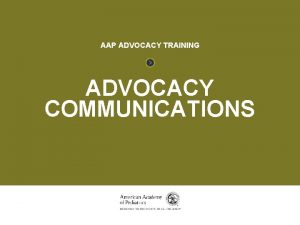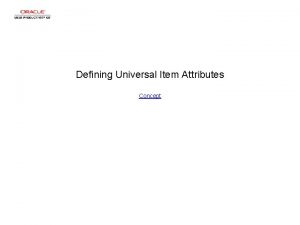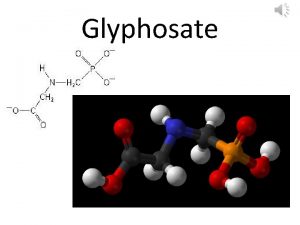Universal Salt Iodization Advocacy and Communications Defining a









- Slides: 9

Universal Salt Iodization Advocacy and Communications Defining a Global Framework Joy Del Rosso, The Manoff Group Expanded Quarterly Meeting—UNICEF/NY January 24, 2012

USI Partnership Premises » Seeking government commitment to adopt and enforce legislation ˃ ˃ Form multi-sector coalition responsible for elimination of IDD Create communications packages for incoming government officials » Aiming to raise awareness among consumers and food/salt industry important to ensure demand for iodized salt Conduct consumer and market research to build brand equity based on “added value” of iodized salt ˃ Improve appeal and performance of iodized product in market place ………………………………………………………. . ˃ » Different approaches within salt industry; not uniform—e. g. , two-tier system (good quality iodized salt and raw, noniodized salt)

Target population for distribution, access , knowledge and demand includes the food industry

Partnership Drivers Supply Advocacy Communications Regulatory monitoring for QC Support multi-sector coalitions for and QA to assure standards met national IDD elimination programs Targeted communications and SM (social mobilization) along the salt supply chain to promote understanding and adherence to salt iodization law and regulations Consolidation of small-scale salt Ensure IDD elimination part of producers to eliminate flow of national nutrition strategy non-iodized salt Targeted communications and SM to consumers in low coverage areas to ensure understanding and demand for iodized salt Promotion of the use of iodized Ensure highest political salt in processed foods commitment for the sustainable elimination of iodine deficiency Inclusion of IDD and USI principles in educational curricula, food technology courses, salt logos, messages on packages and labels Explore the use of public Ensure IDD elimination program distribution systems for iodized management and oversight salt directly functions institutionalized Establish sustainable systems for the procurement and supply of Potassium Iodate (KIO 3) Document innovative practices and lessons learned of the Partnership contributions to USI in all countries

Conventional Wisdom » » » » Periodic advocacy or re-advocacy—maintain political will and focus attention Advocacy at national and provincial, community levels Communication activities need to be integrated within “program” strategy Effective communications requires expertise— not everyone can do it Health sector must coordinate/share responsibility with the salt sector Need to work with all members along the salt chain from top management to the retailers Educators/the education sector is both a major stakeholder and a route to sustainability Audience segmentation is necessary and along with that reaching specific audiences with appropriate messages Jack Ling “The Role of Education and Communication” in Towards the Global Elimination of Brain Damage Due to Iodine Deficiency, 2004. » As visible signs of goiter diminish, focus is (and should be on) less visible impacts » Tailor messages to specific audiences » Understand common wisdoms and correct misinformation » Integrate updated IDD information in to technical and education materials of food inspectors, health and education curricula » Public education supports IDD elimination and creates demand for iodized salt Venkatesh Mannar and Lucie Bohac “Achieving USI: Lessons Learned and Emerging Issues, ” Iodine Network presentation, 2010

Framework Rationale » What is a Framework intended to do? ˃ ˃ Make it easier to work within complex systems—simplify and clarify Tie or bring together relevant, discrete elements or components Help to present a particular methodology or logic Facilitate making recommendations for WHAT to do in the C&A for salt iodization » Why do we need a Framework? ˃ USI is much more complicated that many realize (its “selling” point has been its simplicity) ˃ Communications in particular have not been connected adequately to the main aspect of USI—the salt (industry) ˃ Approach to communications (and advocacy) does not necessarily fall neatly into a particular/traditional approach (social mobilization or behavior change communications) or methodology. ˃ To help identify and ultimately use effectively what we do know (lessons learned, innovations, good practice) more specifically

Advocacy & Communications Framework Advocacy Process Define and Prioritize Environment for Salt Iodization Key Audiences Key Information/ The communication environment ? Salt Iodization Policies and Legislation Communications ? ? ? Salt Production and Supply Salt Distribution and Delivery Retail Sale of Salt Subsistence salt farmers Hard to reach populations Household Salt Consumption National Govt Local Govt Producers Refiners Packers Truckers Re- Packers Distributors Retailers/shop owners General Public (Urban, Rural) Status of legislation and regulations; government commitment Composition, compliance, capacity Imports In-country production Distribution routes, factors Practices purchasing and selling salt Access to iodized salt Beliefs and practices about salt Pregnant women

Framework Use » Step 1: Define the environment (the salt industry including legislation) » Step 2: Identify specific targets within that environment—critical opportunities or challenges » Step 3: Plan for advocacy and communications ˃ Previous experience—any information on what has worked (evidence) ˃ Collect and analyze data and information on different/key audiences (not just consumers) practices related to salt production, distribution, purchase, use » Step 4: Make recommendations for advocacy and communications strategy and implementation

Framework Aims to: » Puts focus and starting point as the salt industry rather than the consumer—sets this as the context for advocacy and communications » Shows communications potentially enters into all aspects of the salt chain via government » Emphasizes the need to build communications and advocacy on data information that provides the context/environment for communications » Highlights the need to prioritize actions based on the environment and to choose among audiences
 Nondefining relative clause
Nondefining relative clause Relative clauses defining and non defining
Relative clauses defining and non defining Defining and non-defining
Defining and non-defining Defining and non defining relative clauses in telugu
Defining and non defining relative clauses in telugu Non defining relative clause definition
Non defining relative clause definition Defining non defining farkı
Defining non defining farkı Categories in research
Categories in research Advocacy goals and objectives examples
Advocacy goals and objectives examples Advocacy communication and social mobilization
Advocacy communication and social mobilization Monitoring and evaluation in advocacy
Monitoring and evaluation in advocacy






